Chapter 1
Beyond the Sales Funnel

The Sales Expansion Loop
My preceding book, Selling to the C-Suite (McGraw-Hill, 2009), demystified why executive buyers single out some salespeople to be Trusted Advisors but give others the ejector seat. The book was based on a decade of research in bull and bear markets, and it reported what leaders across industries and cultures said about how, why, and when they get involved in their companys large purchasing projects.
And with so many people struggling through a financial crisis at the time of C-Suites publication, it hit a chord. I was invited to keynote at sales conferences across North America, Latin America, Asia, Europe, and Africa. Morning and nightly television news shows wanted to hear these tips, as did newspapers, magazines, and drive-time radio. The appetite for certainty in a time of uncertainty was palpable. People put the book to the test. Its lessons helped them. I cherish every tale of success.
Then as the economies of the world continued to wobble, a recurring question was raised by the hundreds of CEOs and vice presidents of sales who drew me aside in boardrooms, airport lounges, and conference mixers.
Their question was this:
Youve shown us how executives buy today. Can you show us how top salespeople sell today?
It was the today part that caught my attention. Have the rules of selling changed? Are they different from how we sold yesterday or during the last decade or the last century? Its an intriguing question.
If we hypothesize that selling is only about skills, then with the hundreds of published works produced in the past two centuries by Carnegie, Ziglar, Hopkins, Tracy, Rackham, Bosworth, Page, Gitomer, and other contributors, surely we already have the academic foundationin books and training coursesto sell effectively. If we only reread and practice their lessons, wouldnt we all perform better? Of course we would. On an individual level we can always sharpen the saw. Covey taught us that.
And that might be enough... if improving our win rate in complex and strategic sales opportunities was a matter of skills execution alone. But few sales directors think its that simple anymore.
Buyers are more risk averse; they seldom make decisions without involving other stakeholders, advisors, or opinion leaders. Its no longer good enough to find and pitch to one economic buyer, fox, or grand poobah in the inner circle. The customers expect you to network with all the players, to make it easy for them to buy by your getting everyone on the same page. To do this, the customers take it as a given that you will do your homework and be curious enough to learn the issues that may affect multiple personas in different ways; to build supporters in these ranks; and to make a case for change and navigate the minefield of competing biases that may cause people in the same company to hold polarized views on whether theres a need to buy, buy now, or buy from you.
The role of business-to-business salespeople today is to provoke people with new ideas so they become dissatisfied with the status quo through gaining a vision of tomorrow. Customers expect us to add value in every meeting, to propose solutions that give the most bang for the buck, and to remain accountable to deliver our promises long after the close.
Your company expects you to convert name lists, networking lunches, and marketing leads into sales opportunities; to keep your pipeline stacked with enough revenue to offset the deals that dont pan out; to qualify out of low-probability deals as fast as possible; to orchestrate the profitable deployment of presales subject matter specialists; to maintain sales records and reporting systems; to coordinate with third-party solution vendors who partner today and compete tomorrow; and to work miracles at the end of each quarter and especially at the end of each fiscal year.
A salespersons job description is seldom written in these terms, but theres no doubt about it, that when you accept a role in the business-to-business sales profession today, its certainly not for the fainthearted nor the enthusiastic amateur. Its one of the toughest (yet most rewarding) gigs in the world. Its a complex, high-stakes, demanding profession.
Does this sound like your world?
Good, that means this book is written just for you.
The best practices youll read here answer the questions executives and sales professionals are asking everywhere. They are drawn from nearly 20,000 hours of interviews, coaching sessions, and field accompaniments with business-to-business salespeople who exceed their targets year after year. To keep the headhunters at bay, you wont read anyones personal names. Their lessons are grouped collectively and listed in this book as being from top sellers or stars. These legends are out there right now, seeding ideas, nurturing contacts, inking fresh deals, and hitting their quotas early in challenging markets. With this book, you will join them.
Lets begin.
Have you noticed that no matter how great your offering, there are times when some prospects just dont value what youre selling? They wont engage in consultative discussions, and they only want you to send an e-mail or provide factual information to fill a supplier comparison table while they hide behind blind tenders and tight lips. Lets call these prospects Product Buyers. By the time they invite suppliers to talk, they can be two-thirds of the way through their buying process, and now they are looking to narrow their options by comparing suppliers against the criteria they have already collated.
At other times you find yourself talking to prospects who know they dont have all the answers yet, and so they are looking to you for advice and insight. After all, youre someone who talks to their peers at other companies. You see what issues their peers are facing and what theyre doing to solve their challenges. This makes you a valuable source of knowledge about what others are doing to achieve reductions in cost, time, and risk or to gain increases in productivity, efficiency, and profit. These prospects welcome you to the table if you bring these insights. Theyre prepared to invest time in you to diagnose their real needs and explore options they didnt know existed. Lets call these Ideas Buyers.
Both types of prospects buy differently, from the depth of conversation theyre prepared to have and the number of people you end up meeting with, to the time it takes to get a signature on the order form.
The skills needed to sell to each type of buyer are identical, but selling to Ideas Buyers requires a broader range of capabilities and the dance steps (i.e. the milestones in your sales cycle) are more complicated.
So lets look at these two sales cycles a little closer.
One is relatively short. It is based on clearly defined or easily influenced decision criteria, where competitors have no great advantage over you, and the decision to buy is held by a small number of Product Buyers (such as those purchasing officers or consultants who tell you to deal only with them and warn you not to go over their head). This type of sale might be declared simple, and the traditional sales funnel is a relatively good model for navigating it. The goal is to move from Hi to Buy as quickly as possible.
When sales stars come across these types of opportunities, they do a preflight check to test whether the premeeting research and first-meeting conversation (whether by phone or face-to-face) are designed to tease out where deeper issues exist and whether the needs and opinions of additional stakeholders can be canvassed to build wider interest and support. They look at how big the iceberg is below the waterline. Their goal is to find topics that allow them to lift the conversation to a poignant issue they can use as a game changer. Theirs is an attempt at
Next page














